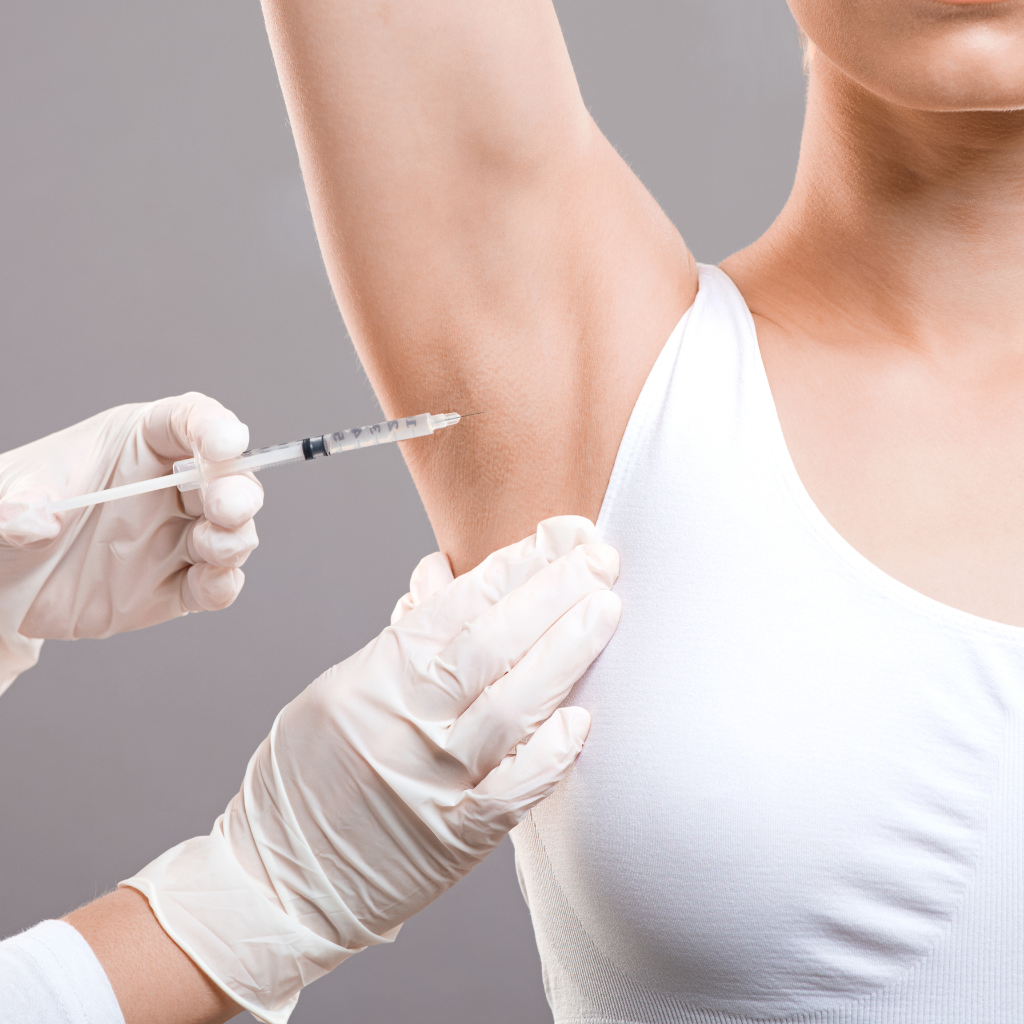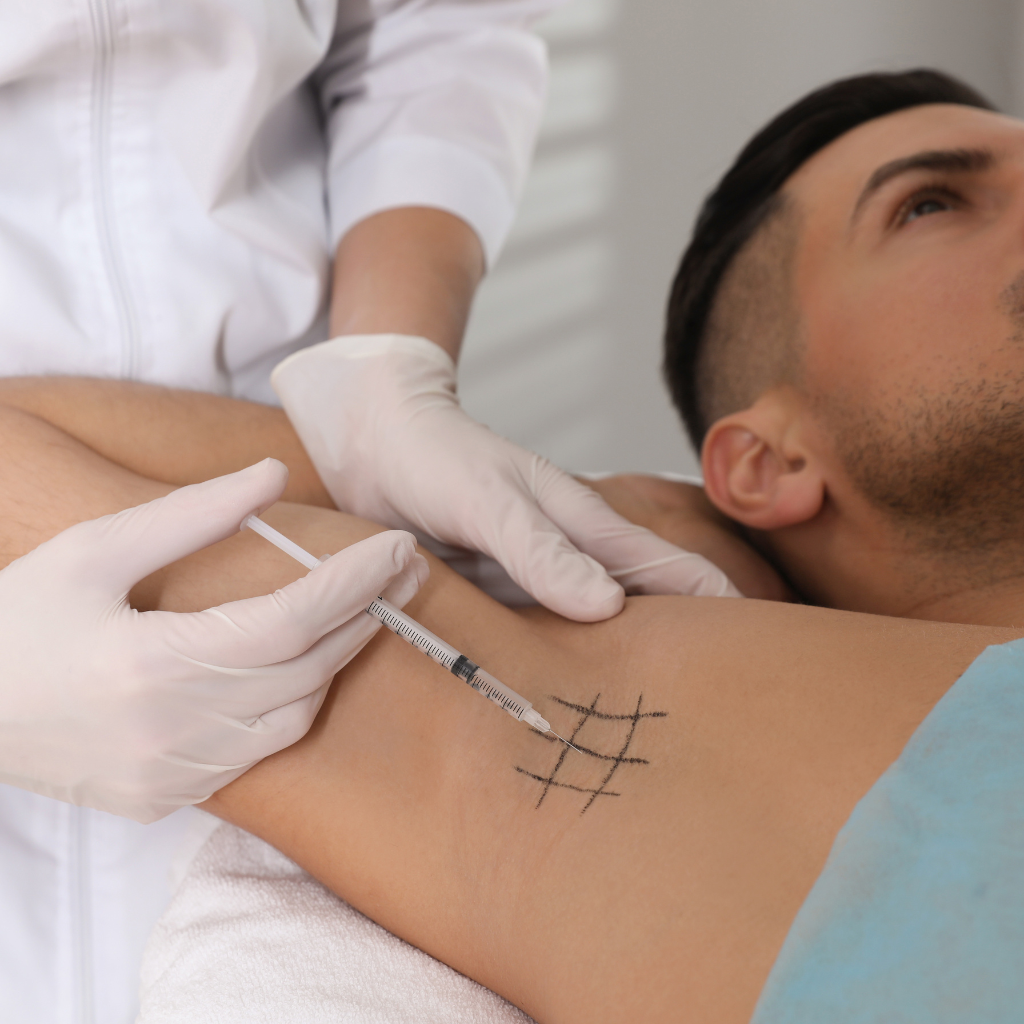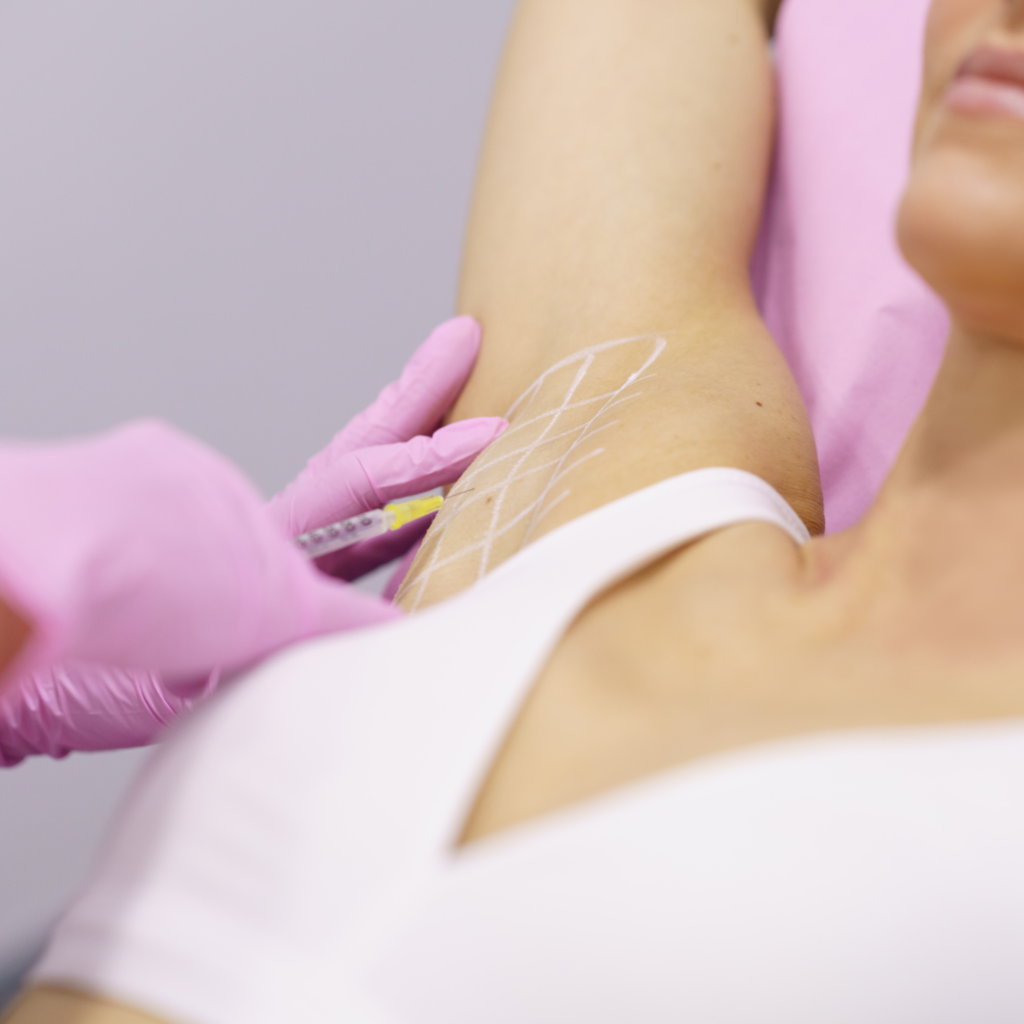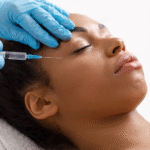Can Botox for Hyperhidrosis Be a Long-Lasting Treatment? Dermatology Insights
- Home
- Anti-aging
- botox for hyperhidrosis

Excessive sweating, known medically as hyperhidrosis, can significantly impact daily life and self-confidence. While there are various treatment options available, Botox has emerged as a popular choice among dermatologists for managing this condition. Botox works by temporarily blocking the nerves responsible for activating sweat glands, providing relief from excessive sweating. However, the key question remains: Can Botox for hyperhidrosis offer long-lasting results? In this article, we explore how Botox functions in treating hyperhidrosis and what patients can realistically expect from this treatment.
Key Takeaways
- Botox is an effective treatment for hyperhidrosis by blocking nerve signals that trigger sweat production.
- Results typically last between 4 to 12 months, depending on the individual.
- While Botox is not a permanent cure, it provides significant relief and improves daily comfort.
- Maintenance treatments are needed to sustain the effects over time.
- A consultation with a dermatologist is essential to determine if Botox is the best treatment option for your hyperhidrosis.
What is Hyperhidrosis and How is it Diagnosed?
Hyperhidrosis is a medical condition marked by sweating that exceeds what the body requires for temperature regulation, greatly impacting an individual’s quality of life.
Diagnosis typically involves a clinical evaluation and may include tests such as the iodine-starch test to confirm the extent of sweat production.
Botox, a neuromodulator, is often utilized in the management of hyperhidrosis due to its efficacy in temporarily blocking the nerve signals responsible for perspiration.
Understanding Botox for Hyperhidrosis
Why do some individuals experience excessive sweating regardless of the temperature or level of physical activity? This condition, known as primary hyperhidrosis, can manifest in various body areas, including the underarms (axillary hyperhidrosis) and palms (palmar hyperhidrosis).
The hyperhidrosis Botox treatment involves using botulinum toxin injections, a clinically proven method to manage excessive sweating. These injections work by blocking the nerves responsible for sweat gland activation, offering a significant reduction in perspiration.
- Botulinum toxin: Temporarily inhibits sweat production
- Injection sites: Typically include underarms and palms
- Treatment duration: Effects may last several months
- Excessive sweating treatment: Offers a non-surgical approach
The precise application of botulinum toxin injections allows for targeted treatment of hyperhidrosis, providing relief for those affected by this condition.
Impact on Quality of Life
How does hyperhidrosis affect an individual’s quality of life? This condition, characterized by excessive sweating, can lead to significant social and psychological distress.
In dermatology, botox injections are a prevalent treatment option. The effect of botulinum toxin, when applied locally, results in a reduction in sweating, thereby improving the quality of life of those affected.
Botox, unlike dermal fillers, specifically targets sweat glands, providing relief from hyperhidrosis. The treatment, however, comes with considerations regarding cost and frequency, as regular sessions are required to maintain its benefits.
Local botulinum toxin injections have been clinically shown to be effective, offering a non-invasive solution to a challenging problem. Consequently, botox stands as a valuable tool in enhancing life quality for people living with hyperhidrosis.
How Does Botox Work for Excessive Sweating?
Botulinum toxin, commonly known as Botox, functions by inhibiting the release of acetylcholine, a neurotransmitter that stimulates sweat glands, thereby helping to stop excessive sweating.
The procedure for administering Botox injections for hyperhidrosis involves targeting specific areas with high sweat production, such as the underarms, palms, and soles, to achieve ideal results.
This treatment requires precision and expertise to guarantee effective coverage and patient safety.
Mechanism of Action of Botulinum Toxin
Excessive sweating, or hyperhidrosis, can be effectively managed through the application of botulinum toxin, commonly known as Botox.
Derived from Clostridium botulinum, the botulinum neurotoxin type A (botulinum toxin-a) is an approved Botox treatment for hyperhidrosis. Its mechanism of action involves the inhibition of acetylcholine release at the neuromuscular junction.
By injecting this neurotoxin into the primary axillary regions, the effects of botulinum reduce sweat gland activity, leading to decreased perspiration.
- Botulinum toxin type: Targets the sympathetic nervous system to control sweating.
- Botulinum toxin-a: Specifically used for medical treatments like hyperhidrosis.
- Mechanism of action: Blocks nerve signals to sweat glands.
- Approved Botox treatment: Offers a non-surgical solution for excessive sweating.
This provides a clinically effective intervention for managing hyperhidrosis.
Procedure for Botox Injections for Hyperhidrosis
While managing hyperhidrosis with Botox, the procedure for injections is both precise and methodically structured. Botox treatment for hyperhidrosis involves utilizing botulinum toxin to target sweating areas, effectively reducing uncontrollable sweating. Understanding the difference between anti-wrinkle and Botox injections is important here, as the primary goal for hyperhidrosis is to block sweat production, rather than relax facial muscles.
The treatment for excessive sweating focuses on the axillary region, among other affected sites. During the procedure, multiple injections are administered directly into the skin of the designated area. A fine needle is used to deliver botulinum toxin for hyperhidrosis, guaranteeing minimal discomfort.
The clinician strategically maps out the sweating areas to guarantee ideal results. These injections for hyperhidrosis temporarily block the nerve signals responsible for sweat production.
As a treatment option, this method provides significant relief for individuals struggling with hyperhidrosis, offering them a more manageable lifestyle.
Areas Treated with Botulinum Toxin Injections
Several areas of the body can be effectively treated with botulinum toxin injections to alleviate excessive sweating, a condition known as hyperhidrosis. This treatment targets focal hyperhidrosis by blocking nerve signals to sweat glands.
Common areas include:
- Face: Botox for hyperhidrosis. The face addresses localized sweating, enhancing patient comfort.
- Axillae (Underarms): A primary area of excessive sweating where botulinum toxin reduces perspiration.
- Palms and Soles: Effective for those experiencing excessive sweating in these regions.
- Scalp: Targets sweat glands to manage scalp hyperhidrosis.
The treatment for hyperhidrosis provides temporary relief, with effects lasting three to six months.
While topical solutions exist, botulinum toxin offers a potent alternative, minimizing compensatory sweating.
Patients must consult healthcare professionals to determine suitability and anticipate outcomes.
How Long Does Botulinum Toxin for Hyperhidrosis Last?
The duration of botulinum toxin’s effectiveness for hyperhidrosis typically ranges from four to six months, although individual variations can occur.
Factors such as the severity of the condition, the area treated, and the patient’s metabolism greatly influence the longevity of results.
Patients may consider scheduling a ‘touch-up’ appointment when they notice the gradual return of symptoms to maintain ideal efficacy.

Duration of Treatment Effects
Curiously, how long can individuals expect botulinum toxin to alleviate hyperhidrosis symptoms? Typically, the effects last between four to six months, with variations depending on individual response and severity of the condition.
Botox is often considered the best treatment for excessive sweating due to its targeted mechanism. Patients may observe diminished symptoms within weeks after treatment, although the duration can fluctuate.
- Cost of botox treatments: Pricing can differ greatly, with the cost of botox for hyperhidrosis affected by region and provider.
- Adverse effects: Most individuals experience minimal side effects, though slight discomfort at the injection site is possible.
- Uses of botulinum: Beyond hyperhidrosis, botox is utilized for various medical and cosmetic purposes.
- Treatments for hyperhidrosis will vary: Frequency and cost are subject to individual needs and therapeutic goals.
Factors Influencing the Longevity of Results
Understanding the duration of botulinum toxin’s effectiveness for hyperhidrosis is contingent upon various factors that can influence individual outcomes. For those wondering how long does Botox last, the longevity of results when applied to the treatment area, such as the palm, typically varies between patients.
According to studies published in the Journal of Dermatology, results can last from a few months to over six months. Factors such as the dosage, the specific treatment area, and the individual’s metabolic rate play significant roles.
Dermatologists emphasize the importance of informed consent, ensuring patients understand potential variability. The cost of Botox should also be considered, as longevity impacts the frequency of treatments.
Observing results days after treatment helps in evaluating efficacy and assisting dermatologists in optimizing long-term management strategies for hyperhidrosis.
When to Consider a ‘Touch-Up’
When determining the appropriate timing for a ‘touch-up’ treatment of botulinum toxin for hyperhidrosis, several factors must be considered to guarantee optimal results.
Typically, the effects of botox for hyperhidrosis last between 4 to 12 months, varying based on the individual’s response and the specific area being treated. Patients with axillary hyperhidrosis might require more frequent treatments to maintain dryness.
Key considerations include:
- Reoccurrence of symptoms: Monitor when excessive sweating resumes in treated areas.
- Treatment of primary sites: Focus on the main sweating areas that may need touch-ups.
- Patient feedback: Communication is crucial for adjusting therapy for hyperhidrosis.
- Clinical evaluation: Regular assessments to determine if hyperhidrosis-treated areas need additional intervention or to ‘touch-up’ any sweating areas showing signs of recurrence.
Regular monitoring guarantees effective management of hyperhidrosis with botulinum toxin type.
What are the Costs and Considerations of Hyperhidrosis Treatment?
When considering hyperhidrosis treatment with botulinum toxin, financial implications and potential risks are key factors.
The cost of Botox for excessive sweating can vary greatly, often influenced by the number of areas treated and geographic location. At the same time, insurance coverage may be limited and contingent on proving medical necessity.
Additionally, patients should be informed about potential adverse effects and risks, including localized pain, infection, and temporary muscle weakness, to make an informed decision.
Cost of Botox for Excessive Sweating Treatment
The cost of Botox for excessive sweating, medically known as hyperhidrosis, varies based on several factors, including the treatment area, geographical location, and the provider’s expertise.
Botox is a recognized hyperhidrosis treatment for various body areas, including the armpits, palms, and soles of the feet. The treatment of primary axillary hyperhidrosis is a common application of Botox, providing effective relief from excessive sweating in the armpit region.
Treatment of severe primary axillary hyperhidrosis often requires a higher dose, impacting cost. In cases of palmar or plantar hyperhidrosis, targeting the palms or soles can further influence expenses.
Consideration of focal axillary hyperhidrosis treatment involves:
- Specialist’s credentials and experience
- Number of Botox units required
- Frequency of follow-up sessions
- Regional cost variations
Insurance and Coverage for Botulinum Toxin Treatments
Manoeuvring the complexities of insurance and coverage for botulinum toxin treatments, such as Botox for hyperhidrosis, requires a meticulous understanding of policy nuances.
Coverage for hyperhidrosis will vary depending upon the insurer, specific plan details, and the sole necessity of medical intervention. Many insurance providers require prior authorization to demonstrate their medical needs, particularly when hyperhidrosis greatly impacts daily life.
The costs associated with treatments throughout the area of excessive sweating can be substantial, and patients must ascertain whether their plan covers partial or full expenses. Documentation from healthcare professionals, including diagnosis and ineffective alternative treatments, often strengthens the case for coverage.
Patients must diligently consult with their insurer to guarantee a thorough understanding and navigate potential out-of-pocket expenses.
Potential Adverse Effects and Risks
While hyperhidrosis treatment with botulinum toxin can offer significant relief, it is not without potential adverse effects and risks. Patients seeking treatment should be informed of the possible complications associated with this procedure.
Understanding these risks allows for informed decision-making and appropriate management should they occur.
- Pain at Injection Site: Mild discomfort or bruising may occur where the injection is administered.
- Dry Mouth: Some patients report experiencing a dry mouth following treatment, which may require additional management.
- Compensatory Sweating: There is a possibility of increased sweating in areas not treated with botulinum toxin.
- Muscle Weakness: Temporary muscle weakness in surrounding areas may be observed, necessitating a balanced risk-benefit assessment.
Clinicians must evaluate individual patient profiles to minimize these risks effectively.

Are There Alternative Treatment Options for Hyperhidrosis?
For individuals seeking alternatives to Botox for hyperhidrosis, several surgical and non-surgical options are available.
Surgical interventions such as sympathectomy offer a more permanent solution by interrupting nerve signals responsible for excessive sweating.
Additionally, lifestyle modifications, including dietary adjustments and stress management, alongside home remedies like the application of antiperspirants with aluminium chloride, can aid in managing symptoms effectively.
What Surgical Options Exist for Treating Hyperhidrosis?
Though hyperhidrosis can be a challenging condition to manage, several surgical options have been developed to address its symptoms effectively. These options are typically considered when non-invasive treatments fail to yield satisfactory results.
Surgical interventions focus on targeting the overactive glands or nerves responsible for excessive sweating. Key surgical procedures include:
- Endoscopic Thoracic Sympathectomy (ETS): Involves cutting or clamping the sympathetic nerves responsible for signalling sweat glands, often used for palmar hyperhidrosis.
- Subdermal Laser Treatment: Utilizes laser technology to destroy sweat glands, reducing sweating in localized areas.
- Sweat Gland Removal: Surgical excision of sweat glands from affected regions, such as the underarms.
- Microwave Therapy: Destroys sweat glands through controlled microwave energy, applicable for axillary hyperhidrosis.
These methods can lead to a marked improvement in life quality for those affected by severe hyperhidrosis.
What are some at-home solutions and daily habits for managing hyperhidrosis?
A variety of lifestyle changes and home remedies can serve as effective strategies for managing hyperhidrosis, especially for those seeking non-invasive solutions.
Individuals might consider wearing breathable, loose-fitting clothing to reduce sweat accumulation and skin irritation. Utilizing antiperspirants containing aluminium chloride can help block sweat glands, decreasing perspiration.
Regular bathing with antibacterial soap can minimize bacteria on the skin, reducing odour. Dietary adjustments, such as avoiding spicy foods and caffeine, may also lessen sweat production.
Stress management techniques, including yoga and meditation, can further aid in controlling excessive sweating by reducing anxiety-related triggers.
Additionally, cool showers and talcum powder application may provide symptomatic relief. These approaches offer practical, non-pharmacological methods to manage hyperhidrosis, promoting improved comfort and quality of life.
Conclusion
Botox offers a highly effective and relatively long-lasting solution for many individuals struggling with hyperhidrosis. While it is not a permanent cure, the treatment can significantly reduce excessive sweating for several months, improving quality of life and confidence. Regular follow-up treatments are typically necessary to maintain results. Consulting with a qualified dermatologist can help determine if Botox is the right option and create a personalized plan for managing hyperhidrosis effectively.

Highly skilled cosmetologist at Tune Clinical Aesthetics, specializing in advanced skin and hair treatments.





